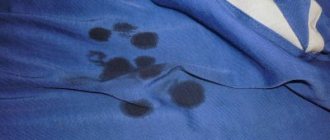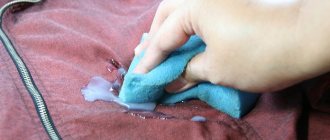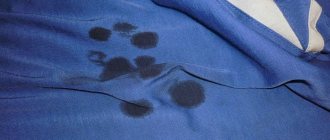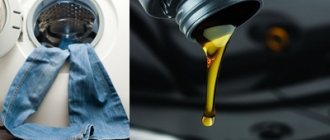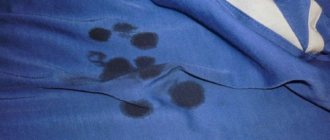During repairs, did the swallows get dirty with machine oil? The problem is known and a solution for it has long been found! In this article we will tell you how to remove machine oil from clothes in a variety of ways.
About the problem in general
Regular washing with powder and soaking will not help here, and a fresh stain can stain an adjacent area of fabric or the drum of the washing machine. To remove oil, you will need aggressive chemicals that can ruin your clothes. Therefore, it is better to carry out preliminary testing by applying the composition on the wrong side of the seam or hem. They must be used carefully, using rubber gloves.
There is no point in rubbing an oil stain with a dry cloth or brush without a cleaning agent. The fat will only be spread over the surface and absorbed deeper into the material. It’s better not to rack your brains than to wash off machine oil, but to use one of the methods given, taking into account the characteristics of the material.
Important: as soon as a stain appears, you should immediately blot it with a paper towel or clean rag to avoid further spread. After this, start making a print.
Using caustic soda
This is a last resort if other methods have failed and if the engine oil is particularly thick and corrosive. In this case, you need to act with extreme caution. Hands must be wearing latex gloves.
Preparation of the mixture:
- To remove stains, you need to take dry lye flakes and dilute them with cool water to a paste.
- The chemical reaction will be accompanied by the release of a large amount of heat, so the risk of getting a burn has not been canceled.
- After complete dissolution, you need to try the effect of the mixture on an inconspicuous area.
- Apply the mixture with gloved hands, rub and rinse off.
- After processing the fabric, it must be rinsed thoroughly and finally treated with water acidified with vinegar or citric acid.
- Rinse in clean water or with rinse aid.
- Dry as usual.
Synthetic fabrics usually do not withstand such influences well, while natural ones can withstand literally several times. But at the same time you can easily eliminate greasy stains.
Removal from jacket
- Blot a fresh stain on the surface of a synthetic jacket with a rag and squeeze a little dishwashing detergent onto it. Do not rub the gel in and leave it on the fabric for 15-30 minutes. Blot with napkins until traces disappear and machine wash with powder.
- Remove oil stains on bolognese clothing or a down jacket using a solution of ammonia. To do this, add a teaspoon of ammonia to 100 ml of water. Treat the dirty area and leave for an hour. Rinse with running water and wash with detergent. You should not experiment with undiluted alcohol to prevent the fabric from fading.
Important: adding washing powder to the dish gel will enhance the cleaning effect.
Cotton jacket
- Kerosene successfully removes machine oil prints from natural fabrics. The substance is poured directly onto the stain, and then collected with a cloth in the direction from the periphery to the center so as not to leave streaks. All that remains is to wash the jacket with detergent.
- Mustard powder will help remove motor oil from cotton. You will also need a brush, soap and warm water. Rub the fabric with soap and sprinkle powder onto the stain. Moisten the brush with water and rub the dirt. Rinse.
- Light-colored cotton jackets are cleaned by sequentially using three components: hydrogen peroxide, baking soda and dishwashing liquid. Peroxide is applied to the entire surface of the stain and covered with a thick layer of soda. Pour dishwashing gel evenly over the components and sprinkle with baking soda again. Rub the area with an old toothbrush and leave for an hour. Without rinsing off the composition, wash with detergent.
- For dark clothes, activated carbon, crushed to a powder, is suitable. Sprinkle it on the stain and wait until the oil composition is absorbed.
Suede
- Gasoline is suitable for cleaning dark and light suede material. It is enough to place napkins soaked in gasoline on both sides of the machine oil stain. Leave for effect. After about half an hour, the napkins will be saturated with oil and the clothes will be clean. Now you just need to wash the surface with detergent and dry.
- Treat the suede with car oil stain remover spray. The product perfectly copes with old and stubborn dirt, and very quickly.
- Sprinkle starch or talc onto a fresh oil stain to absorb the grease. After some time, remove the residue with a brush.
Basic Tips
It is much more difficult to remove an old machine oil stain than a fresh one, so if you decide to save the item, do not delay the procedure for several days, otherwise the fat will be firmly absorbed into the structure of the fabric.
Most products have an aggressive effect on the fabric. Before use, test the substance by applying it to an inconspicuous area, evaluate the result after 20-30 minutes - the fabric should not change color or become rough.
Use of powder absorbents
Powder products also work well with machine oil, due to the fact that their particles absorb fat and promote its absorption from the fibers. This method of removing stains is not only effective, but also safe for any type of fabric. The most effective means:
- Chalk - perfectly absorbs fuel oil, engine oil and other petroleum products. Can only be used to remove fresh stains. Grate the chalk until you get a powder. Place the clothing on a smooth surface and sprinkle generously on the stained area. Leave it like this for 1 hour. After this, wash the item thoroughly. If necessary, the procedure can be repeated.
- Salt - helps remove fresh stains. Not suitable for getting rid of heavy dirt. You will need fine table salt, which you need to sprinkle on the stain and leave for 2 hours. Then wash the item by hand or in a machine.
- Talc or starch. A mixture of these absorbents can be used. They perfectly absorb different types of fats. Talc or starch should be poured onto the stained area and shaken off after an hour. Repeat the procedure and then wash the item.
- Sugar is an excellent way to remove grease from cotton items. First you need to wet the clothes in hot water and thoroughly rub the stained area with laundry soap. Then sprinkle sugar on top. Rub the stain for 3-4 minutes. Then rinse and repeat the procedure.
Using detergents
Detergents will help deal with greasy stains. They are safe even for delicate fabrics. The most effective:
- Dishwashing gel. 3 tbsp. l. The products must be dissolved in hot water (about 8–10 l). Place the contaminated item there. Rub a little gel into the stain and leave for 6–8 hours. After this, rinse the item thoroughly.
- Laundry soap. Place the item in hot water for 40 minutes. Then thoroughly rub the contaminated area with laundry soap. Wash as usual and repeat the procedure.
Removing stains from denim
- To clean, traces of oil on jeans are treated with a solvent, and then rubbed with a brush with washing powder, which is poured onto the fabric and moistened. Use the technical product carefully so that the color of the product does not change.
- In some cases, a mixture of ammonia and turpentine is effective for denim. It is applied to the dirty area and wiped with a cloth. Wash clothes in soapy water several times until the smell is removed.
- Rub the machine oil stain with a bar of laundry soap and clean thoroughly with a stiff brush. Repeat until the oil mark disappears.
Tip: traces of soda, starch or chalk are easily removed during the washing process. Therefore, the grains remaining after cleaning are not a problem.
Removing fresh machine oil stains
After getting rid of the excess, it is recommended to wash with laundry soap to remove traces of solvents and engine oil residues. It has a high pH level, making it easy to remove grease stains.
First of all, you need to thoroughly blot the stain, periodically changing paper napkins. After oil absorption has stopped, you can begin further cleaning, taking into account the properties of the fabric and the admissibility of certain methods. But, in any case, removing fresh stains will not be so difficult.
After getting rid of the excess, it is recommended to wash with laundry soap to remove traces of solvents and engine oil residues. It has a high pH level, making it easy to remove grease stains.
From T-shirts
- A T-shirt smeared with machine oil during car repairs can be washed off with tar soap. The cloth in the affected area is moistened and soaped. For best effects, you need to hold it for 1-2 hours. Then wash with powder.
- The WD-40 aerosol familiar to motorists can remove machine oil on knitted clothing. He will also need baking soda and dish gel to help. Apply the spray liberally to the dirt, sprinkle with baking soda and rub. The baking soda that has absorbed the oil will begin to clump. The procedure must be performed 2-3 times. Finish by rubbing in dishwashing detergent and washing with powder.
- Knitwear made of delicate fabric that cannot be rubbed, it is recommended to remove traces of machine oil with hairspray. Spray a small amount onto the stain, and then wash with a product suitable for this type of fabric. The whole secret is in the alcohol that can dissolve the oil, which is contained in the varnish.
Important: You can only use the automatic clothes dryer if the stain no longer exists. Exposure to hot air fixes the mark on the surface.
Features of cleaning materials
Depending on the density and type of material, intensity of contamination, color of the product and other parameters, there are different cleaning methods:
- Cleaning jeans and jackets (down jackets) is complicated by the fact that their structure is very dense. Lubricating oils are almost impossible to remove with conventional washing powders; bleaches can completely ruin the item if used carelessly. When cleaned with a brush, these items of clothing may become thinner and also lose their properties. Because the fabric is dense, liquids are absorbed slowly. This means that stains that look fresh are covered (without rubbing!) with dish soap, then the dirt is removed with cloth napkins and the clothes are washed as usual.
- Dry mustard helps remove oil from the surface of jackets. It is soaked to make something like porridge, applied to the contaminated area for 30 minutes, then the dirty item is rinsed in warm water. Even thick clothes can be cleaned with kerosene, which is poured onto the surface of the stain and after a few seconds they begin to push it towards the center of the stain.
With this method, you will need to remove stains by washing in the hottest water possible, and if the fabric cannot withstand such treatment, you will have to refuse.
- Jeans are affected by oil more often than any other material, and it is very difficult to remove such stains. It is recommended to start processing by applying a solvent, and do not rub too hard, otherwise the surface will fade. Then sprinkle the jeans with washing powder, spray with water and rub with a brush (vigorously, since weak movements will not get rid of stains). Special sprays can also remove oil stains from jeans, but only if the stain is not old.
- The most energetic preparation that is suitable for jeans, but absolutely not suitable for Bologna fabric, is a combination of ammonia and turpentine. Be prepared for the fact that the item may deteriorate irrevocably! If you still want to take a risk, apply the mixture to the clog and clean it with a soft cloth. Then you will need several hand washes with changing soap solution. Even with complete success, a persistent unpleasant odor may remain.
- It should be noted that jeans and outerwear may not be free of oil in all cases. Thus, the thinnest materials with the necessary processing will simply collapse and lose their appearance. The most universal reagent is gasoline for lighters, which is used to soak a couple of napkins applied from different sides. After 30 minutes, the oil will remain only on the napkin.
The classic blue color of the jeans means no solvent can be used at all; dark varieties of fabric can be processed repeatedly, only by carefully monitoring the color of the material.
- Oil stains can be removed from white or very light pants by treating with oxygen bleaches. Considering their great activity, strictly follow the instructions, and if the product used does not help, do not try to experiment further, contact a professional. When cleaning bolognese cloth, the inside of the stain should rest on a board or hard cardboard. When rubbing the surface of the stain, never apply excessive pressure.
- Bologna can be washed only at temperatures no higher than 40 degrees, and by hand, and it should be wrung out more carefully. Ironing such clothes after cleaning is unacceptable; they should only be dried at room temperature away from sunlight and heating devices. It is better not to clean bologna with brushes; as a last resort, use the least hard ones and brush smoothly.
Sweater
- Use a wool stain remover.
- You can remove engine oil prints using denatured alcohol and turpentine. Mix the components in equal parts and apply to the stain with a cotton pad. Repeat the treatment until the stain disappears and wash the item as usual.
- Hot water, which breaks down fat well, cannot be used for woolen sweaters. It will be replaced by corn starch and dish gel. Cover the stain with starch powder in a dense layer. After 30-60 minutes, clean the item with a brush. Apply dish gel to the remaining mark and spread with your finger. Meanwhile, fill a basin with cold water and foam a little product in it. Immerse the sweater completely and leave for 15-20 minutes. Wash without twisting or stretching, rinse until clean. Let drain and wring out with a towel. Dry flat.
- Salt can save a sweater from the fibers absorbing oil and spreading it. A fresh stain is generously covered with salt. As a good absorbent, it will absorb liquid and after that a simple wash will be enough.
Advice: when using technical equipment, you should work in a ventilated area. Place a cotton cloth or piece of cardboard under the stain to avoid transferring to another surface.
The use of folk remedies
Folk remedies help get rid of both old and fresh stains. Before using any of these methods, it is advisable to first try on a less visible area of clothing. The most effective means:
- Petrol. You will need a product purchased at a hardware store. Standard gasoline from a gas station will not help. It is necessary to place the item in a basin and thoroughly treat the contaminated area with the solution. Leave for 5-10 minutes. Then wash in soapy water. This method can harm silk fabric.
- Turpentine and ammonia. This mixture is best used for cleaning white fabrics. It is necessary to take both ingredients in equal proportions and mix. Apply the resulting product to the contaminated area, after wearing rubber gloves. After 15 minutes you can start washing.
- Mustard. This method is suitable for dark fabrics. You will need mustard powder, which must be dissolved with warm water to obtain a paste. Then apply to the stain and leave for half an hour. Then rinse thoroughly in warm water.
- Dentifrice. This product is only effective for removing fresh stains. The contaminated area should be generously sprinkled with tooth powder and left for half an hour. Then wash the item.
- Butter. It must first be melted. Then rub into the stained area and leave for 20 minutes. After this, wash the item using dishwashing detergent. Suitable for different types of fabrics and fresh stains.
Removing a fresh stain from machine oil will require a minimum of effort and time, but dealing with old stains is very difficult and in most cases you cannot do without the help of dry cleaning.
From tracksuits, trousers
- Sportswear can be washed with any of the degreasing agents. Solvent, acetone or nail polish remover will do. Wipe the machine oil stain with a sponge soaked in any of the chemicals. Leave for 30-40 minutes and wash with regular detergent.
- Mix magnesia powder with ether until paste-like. Cover the contaminated area of the pants completely with the paste and rub into the fabric with gentle movements.
- A wool tracksuit is restored after oil contamination with a special solution of dish gel, white vinegar and warm water. The proportion is maintained 1:1:6. Apply the mixture to the stain and carefully scrub it off with a toothbrush. Leave for 5-7 minutes and blot the composition with a damp and dry towel.
Preparatory work
When preparing to remove a stain, be sure to protect yourself. All any active cleaning agents should be used only with rubber gloves, and the most powerful reagents and mixtures can harm the respiratory system. Carefully read the instructions for the drug or reviews about using a homemade product before you start working. Make sure that the type of fabric can be processed in a certain way. Finally, strictly follow the technical rules, otherwise, instead of removing the stain, you can wash it over a larger area or transfer it to other clothes.
When using a product that has not been tried before or when trying to clean a new item, first test the effect of the reagent on a similar sample of fabric or on a visually inconspicuous area. If everything goes well, you can proceed.
How can I wash it?
Some useful tips:
- You can wash things using a car spray; you should use it strictly according to the instructions, and then the dirt will be removed almost immediately. This product effectively fights even deeply penetrated contaminants. Since not all homes have this spray, you can use dishwashing detergent instead. But they can only cope with fresh machine oil and need to soak the fabric for 4 or 5 hours.
- Adding any washing powder to the dish soap helps enhance the effect. If you are looking for something to use to remove machine oil stains, there is a soap specifically designed for this purpose. In it, the problematic item is washed in warm water and left for ½ hour. Then they consolidate the result by washing the clothes in the machine according to the usual program.
- In the absence of both dish soap and powder, toothpaste can remove machine oil: rub it on soiled clothes and then do a regular machine wash. You can also use other products of a homogeneous composition: coarse fabrics can be easily cleaned from paint solvents, after applying which, the stains are thoroughly wiped with a stiff brush. The same wash completes the processing.
- In many cases, pure turpentine, without foreign impurities, works well: it is dripped onto the stain in a small amount, then thoroughly rubbed, the clothes are washed and aired. You can remove machine oil that has just spilled onto the fabric this way: remove the liquid part of the stain with a napkin or towel, pour a small amount of dish soap onto the stain, then, after 20 minutes or a little more, work with a brush. All that remains is to wash the clothes in their usual washing mode.
- If there are fears that it will not be possible to wipe off the stain (this happens when turpentine and other strong means are not applicable), all that remains is to use the most gentle methods possible. Specifically, dust oily stains with talcum powder, cornstarch, or baby powder. After applying this layer, the item of clothing must be left alone overnight or for a day. Then the powder particles are brushed off, and the item is washed in warm water without additional reagents.
- If you need a faster effect, sprinkle chalk on the stain; it works in 1-2 minutes. True, you will need to wash your clothes so that there are no white streaks left.
- When you don’t want to experiment with various homemade products, and want to achieve the optimal effect, you should use synthetic stain removers. This is a completely reliable and safe method. And Antipyatin can serve as a decent replacement for laundry soap. The dirty area is rubbed with a special soap and left for 15 or 20 minutes, after which the fabric is hand washed in a solution of the same product.
It is easy to eliminate the residual odor of this excellent product: rinse the item in the washing machine, being sure to add a small portion of fabric softener.
Cleaning off silicone grease
This white translucent substance can be found on the factory floor and in normal everyday life. Thanks to it, rubber parts found in various parts are less damaged. Silicone grease can be found in equipment used in various fields, for example, dentistry or printing.
It is used by plumbers and laboratory chemists. At home, it is used for lubricating locks, hinges, seams, sealing and sealing. The tightness determines its frequent use for repair and construction purposes. It is not surprising that such grease often ends up on clothes and other things.
Vinegar is suitable for cleaning acid-based grease. First, we protect ourselves with goggles, a respirator and gloves, treat the problem area with acetic acid (70%), and after half an hour we get rid of traces of silicone with a clean cloth.
Be sure to work carefully so that acetic acid vapors do not harm the skin of your hands, mucous membranes and respiratory tract. An alcohol-based substance can be removed from fabric with alcohol (technical, denatured, medical) or regular vodka. Soak a clean cloth in alcohol and apply it to the stained area until pieces of silicone begin to come off the material.
